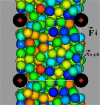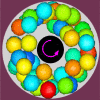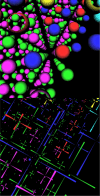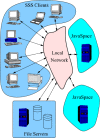Accelerating Scientific Discovery Through Computation and Visualization II
- PMID: 27446728
- PMCID: PMC4861354
- DOI: 10.6028/jres.107.019
Accelerating Scientific Discovery Through Computation and Visualization II
Abstract
This is the second in a series of articles describing a wide variety of projects at NIST that synergistically combine physical science and information science. It describes, through examples, how the Scientific Applications and Visualization Group (SAVG) at NIST has utilized high performance parallel computing, visualization, and machine learning to accelerate research. The examples include scientific collaborations in the following areas: (1) High Precision Energies for few electron atomic systems, (2) Flows of suspensions, (3) X-ray absorption, (4) Molecular dynamics of fluids, (5) Nanostructures, (6) Dendritic growth in alloys, (7) Screen saver science, (8) genetic programming.
Keywords: FEFF; FeffMPI; Hylleraas-Configuration Interaction; Lennard-Jones; QDPD; discovery science; genetic programming; immersive environments; nanostructures; parallel computing; scientific visualization; screen saver science.
Figures





























References
-
- van Dam Andries, Forsberg Andrew S, Laidlaw David H, Jr, LaViola Joseph J, Simpson Rosemany M. Immersive VR for Scientific Visualization: A Progress Report. IEEE Computer Graphics Appl. 2000;20(6):26–52.
-
- DIVERSE: Device independent virtual environments-reconfigurable, scalable, extensible (online) (url: http://www.diverse.vt.edu/). Accessed 8 April 2002.
-
- Kelso John, Arsenault Lance E, Satterfield Steven G, Kriz Ronald D, DIVERSE: A framework for Building Extensible and Reconfigurable Device Independent Virtual Environments Proceedings of the IEEE Virtual Reality 2002 Conference; 24–28 March 2002; Orlando, FL. 2002. url: http://math.nist.gov/mcsd/savg/papers.
-
- Kerighan Brian W, Pike Rob. The UNIX Programming Environment. Prentice Hall, Inc; 1984.
-
- Open Inventor(TM) (online) url: http://oss.sgi.com/projects/inventor/
LinkOut - more resources
Full Text Sources
